Grappling with a slightly rusty chain bolted into the hard, cold rock, I heave myself up onto the relative safety of a flat ledge. The respite provides a chance to take in the stunning mountain views spread out before me. Having started out the morning in the green, beautiful valley below, I was now close to 3,000 meters, looking ahead to a full afternoon of scrambling and clambering along the precipitous ridge towards a hut that promised the comfort of a warm futon and piping hot food.
On days like these, when the sun shines and the rock is dry and firm underfoot, exploring the many high, challenging ridges of the Japan Alps is pure joy. It’s a heady mix of eye-popping views and muscle-straining exhaustion—with the smattering of mild terror and adrenaline-fueled highs during knife-edge ridgeline traverses.
Also known as the Japanese Alps, these mountains lie in the center of Honshu and are divided into three main ranges: the North (Kita), Central (Chuo) and South (Minami) Alps. They are home to the highest peaks in the country, twenty of which reach over 3,000 meters. Only Mt. Fuji reaches higher.
For those with a penchant for thrilling rock scrambles and challenging ridge walks, the North Alps (traditionally known as the Hida Mountains) is undoubtedly the place to be. A roughly Y-shaped band of rugged mountains stretching 100 kilometers south from the Sea of Japan coast, this range has volcanic origins with a number of currently active volcanoes and plenty of hot springs thanks to all the geothermal activity. The northern end of the range is subject to freezing Siberian weather fronts during the long cold winters and so is home to some of the best ski resorts in the country. Yet, it is the rocky mountain trails that attract hikers throughout the summer and fall.
HAKUBA
Hakuba is a resort village at the northern end of the Kita Alps. Just west of it lies Mt. Shirouma, one of Japan’s hyakumeizan (100 famous mountains). Its year-round snow fields and abundance of wild alpine flowers make it a popular hiking destination in the summer, and the main ridge leading south crosses over Mt. Karamatsu and then climbs up to the summit of Mt. Goryu for a fine multi-day ridge walk. There are a number of ropeways and trails leading up from the Hakuba side, with a variety of ways to approach and escape the ridge. The stretch heading even further south between Mt. Goryu and Mt. Kashimayari is where things start to get really interesting and requires scrambling skills on a path that barely clings to the mountainside. Halfway along this section is the Kiretto-goya, a cozy mountain hut located in a truly amazing (and slightly terrifying) spot—delicately perched on a narrow saddle with nearly vertical drops on either side. There is no space for camping, but the hut offers welcome relief from the challenges of the ridge.
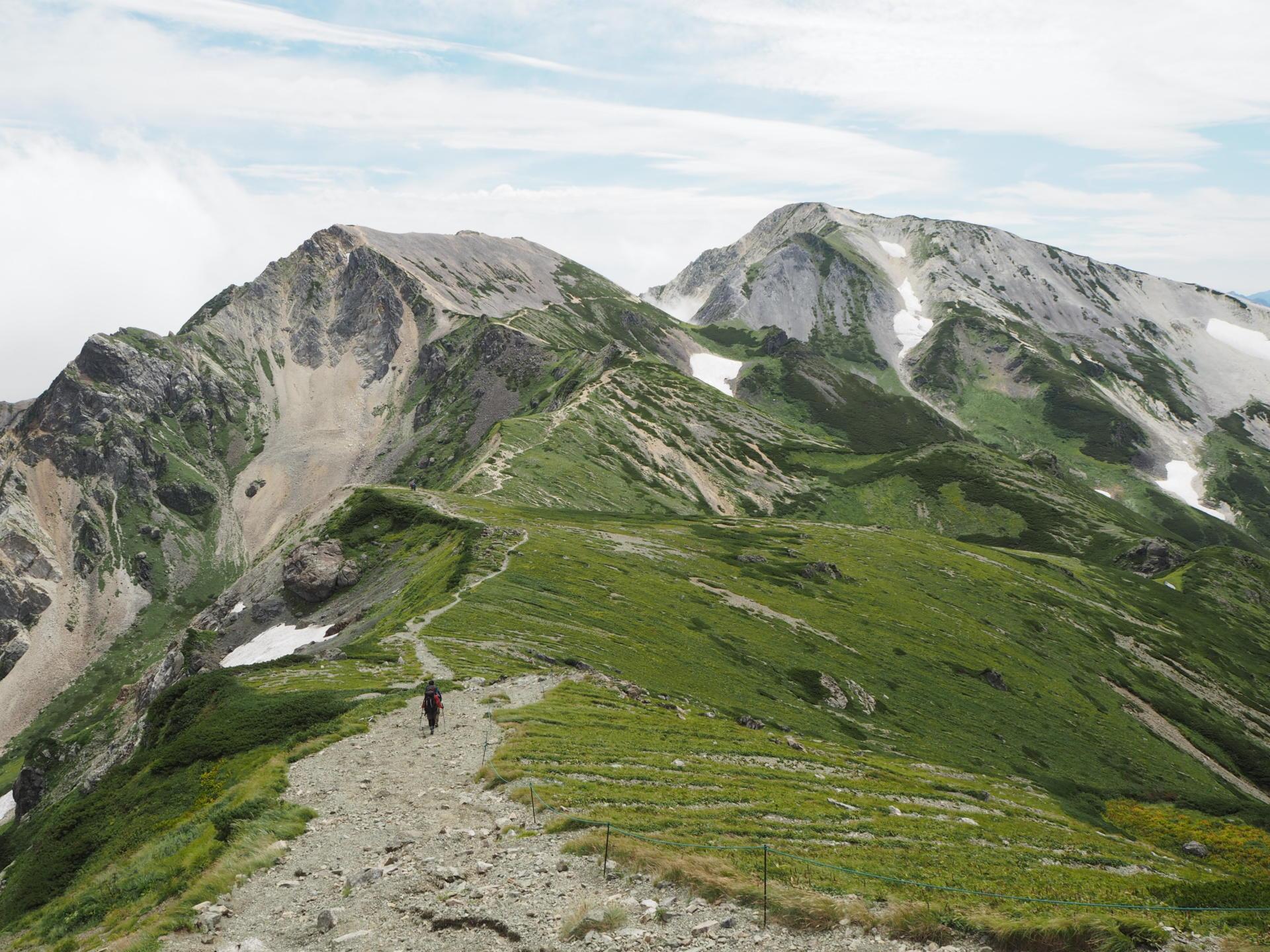
TSURUGI-DAKE
In clear weather, hikers will notice a dark and jagged pyramid-shaped mountain looming ominously across the valley to the west. This is Tsurugi-dake, the last mountain in Japan to be officially climbed and often regarded as the most difficult. It offers numerous challenges to experienced mountaineers, but even the standard route, which approaches from Murodō and then up the Bessan-one ridge, is one of the most thrilling climbs in the entire Alps. Hikers must grapple with multiple fixed chains and huge drops, so sure footing and a head for heights are a must. The most notorious section is known as the Kani-no-tatebai and involves a vertical climb up the cliff face with only a few metal bolts to grab on to, but this is only one part of a demanding four-to-five-hour climb (up and down) from the starting point at Kenzan-sō Hut.
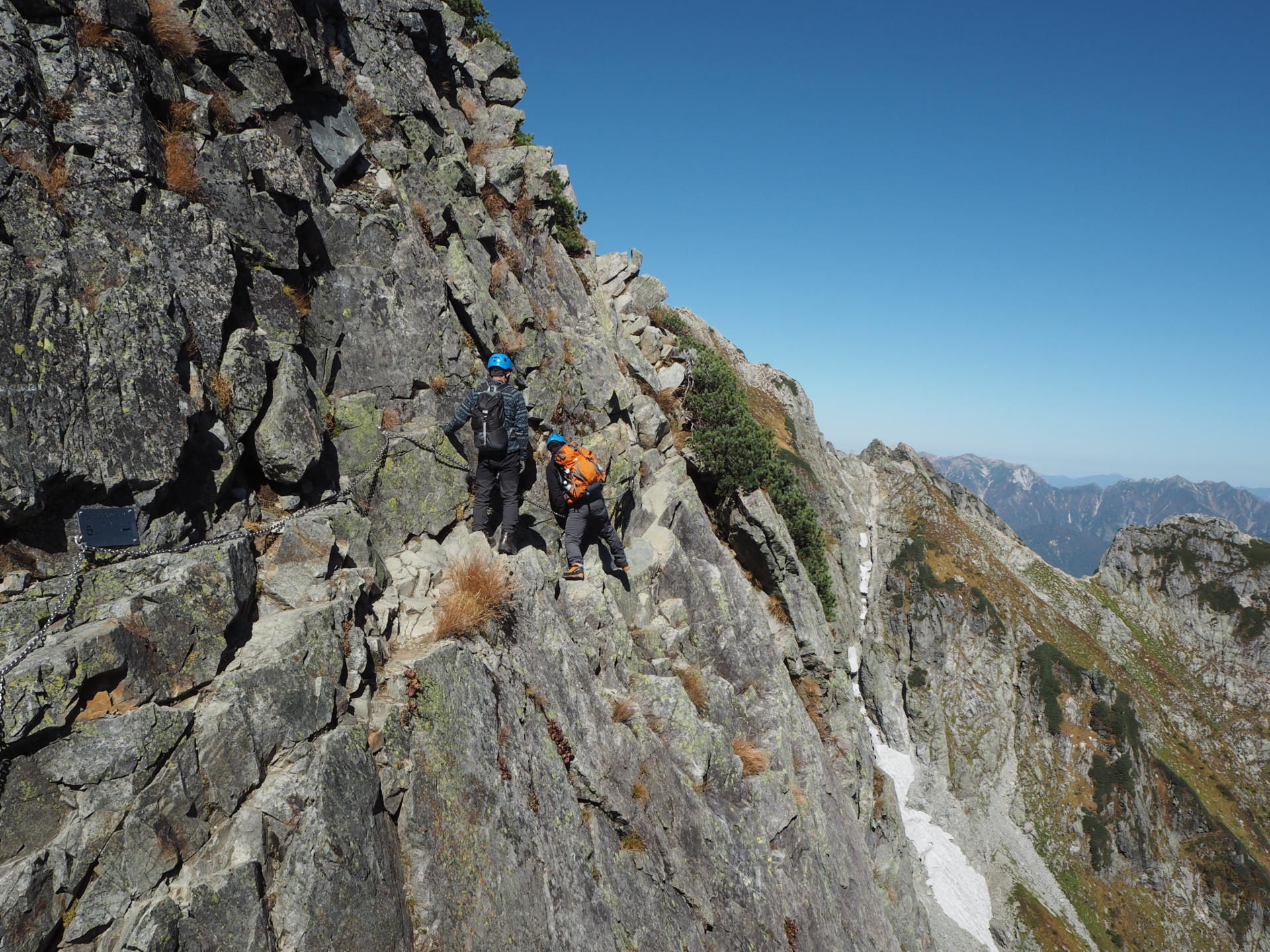
Tsurugi-dake can also be combined with a traverse of the nearby Tateyama ridgeline for a demanding but spectacular three-day trek. Tateyama is one of Japan’s three sacred mountains, and while crowds of people make the short climb up from Murodō to Oyama (one of its three main summits), far fewer continue all the way along the ridge to the summits of Ōnanji-yama (the highest summit) and Fuji-no-oritate. The Tateyama massif is an impressive jumble of rock, with one of Japan’s only remaining glaciers hidden on its eastern flank (the others are to be found on Tsurugi-dake), and while the ridge walk is not particularly difficult it offers splendid views and plenty of easy scrambling and boulder-hopping.
Heading north towards Mt. Matsugo, the drop down from the summit plateau passes Kuranosuke Cirque, a spectacular spot where ancient snow lingers throughout the year. The trail continues on to Mt. Bessan, from where hikers can either continue on towards Mt. Tsurugi, or loop back to Murodō via the huts and campground at Raichōsawa.
DAIKIRETTO AND YARIGATAKE
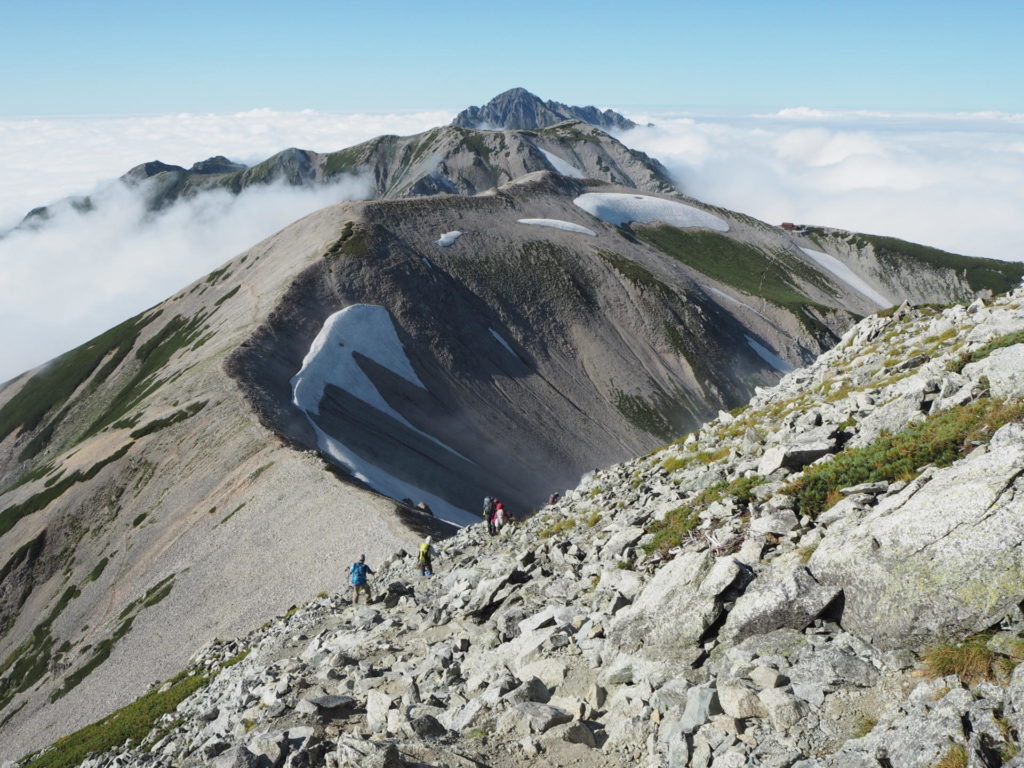
Arguably the most famous of all the ridges in the Japan Alps is the Daikiretto, a heart-stopping section of ridge connecting Mt. Yarigatake and Mt. Hotaka-dake, two of the Kita Alps’ most iconic mountains. Translating to “big cut,” the Daikiretto is a gaping gap in the ridgeline, which, from either the north or south approach, involves awkward downclimbing and a traverse across a mostly knife-edged spine of ridge, followed by a steep climb up the other side.
To the north of the Daikiretto, Minami-dake features staggering views of the Hotaka massif and a comfortable hut and campground nearby. A path follows the ridgeline further north crossing rocky but humpbacked peaks to reach Yarigatake in around three hours. This is one of the four main ridges leading directly to the summit of Yarigatake—each route offers a vastly different kind of approach. The Nishikama Ridge, on Yarigatake’s west side is narrow and high, with fantastic views of the peak’s towering spire summit along the entire route. The Higashikama Ridge, on Yari’s eastern flank, is a well-trodden trail that forms part of the Omote Ginza route leading all the way to the ever-popular Mt. Tsubakuro.
Despite its popularity, there are plenty of fixed ladders and scrambling sections to contend with so don’t underestimate it. The infamous Kitakama Ridge, leading up the north face of Yarigatake directly onto the summit, is by far the most challenging and remote approach and has claimed a number of lives over the years including a number of well-known Japanese alpinists. It is mostly a rock scramble, but route finding and lack of water can be problematic—many people opt to take rope. The other three ridges lead to Yarigatake Sansō, the hut directly below Yarigatake’s summit, and all three have trails which are well marked and straightforward for adventurous hikers.
HOTAKA-DAKE
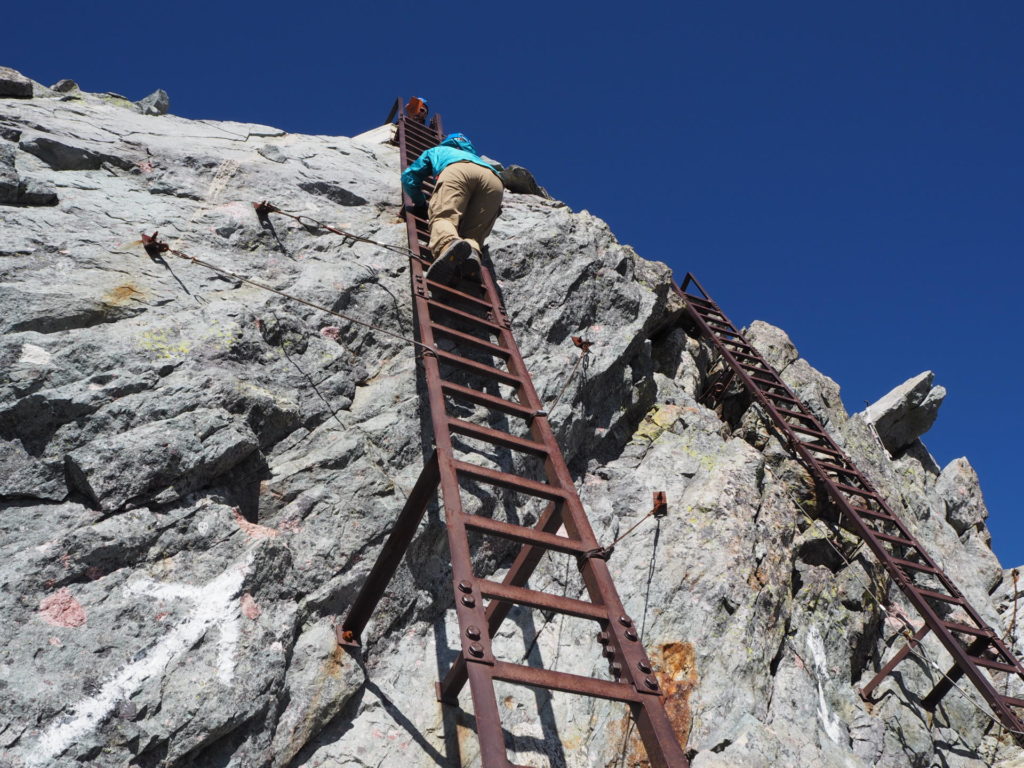
To the south of Yarigatake and the Daikiretto is Hotaka-dake, a chaotic massif of jagged rocky turrets with a high point of 3,190 meters on the main summit of Okuhotaka-dake, making it the highest peak in the North Alps (and third highest in Japan). The ridgeline between the peaks of Kita-Hotaka and Oku-Hotaka takes around three hours to traverse and involves some of the most exciting scrambling and easy rock climbing in the Alps. There are plenty of chains and paint marks to make things easier, but this is not a route for the faint hearted as it is an unrelenting scramble up and around awkward shards of rock—it is full of steep climbs and even steeper, dizzying drops. Hotaka-dake Sansō is another one of those huts built in a seemingly impossible position on a narrow ledge below Oku-Hotaka, and offers comfort and respite from the challenges of the ridge.
Leading southwest from Mt. Hotaka’s main summit is the notorious Nishi-Hotaka Ridge, an epic ridgeline of crumbling rock towers, countless minor peaks and the sharpest knife-edge ridges in the Kita Alps. It poses countless interesting challenges for experienced scramblers, including a climb up to the top of the unmistakable Gendarme, a fin-like protrusion of rock with sheer drops on either side. Most people start early from Nishiho Sansō Hut (open all year) and work their way along the ridge for the eight or nine hours it takes to traverse across to Oku-Hotaka and Hotaka-dake Sansō. It is an extremely long and committing route, only for those with excellent fitness and lots of scrambling experience, but if you like excitement and have a good head for heights it is arguably the most thrilling and enjoyable of all the “regular” ridge routes in the Japan Alps.
Hiking and Trekking Guide to the Japan Alps and Mt. Fuji
Tom Fay and Wes Lang recently published “Hiking and Trekking in the Japan Alps and Mount Fuji,” the first English-language guidebook dedicated to the Japan Alps and Mt. Fuji areas. The essential guide provides comprehensive coverage of the Northern, Central and Southern Alps, plus all four trails on Mt. Fuji and another route on nearby Mt. Kurodake. The book includes:
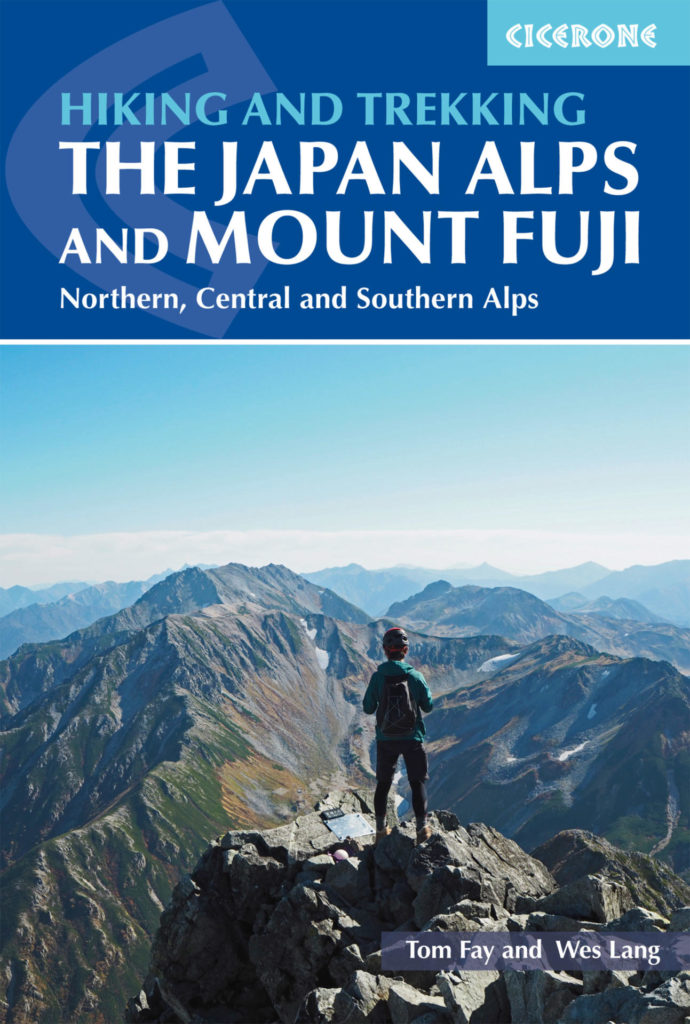
- 27 walks and treks for hikers of all abilities, including straightforward day hikes, challenging scrambles and multi-day treks
- Full color photos and maps with elevation profiles
- Detailed information on mountain huts, camping, access, when to go and transport options
- All routes graded by difficulty, length, terrain and exposure
- Practical advice on gear, travel, accommodation, food, wildlife and much more
- Extensive appendices include route stats, mountain hut listings, Japanese glossary, useful resources and further reading
Tom Fay is a British travel and outdoors writer living in Osaka and the main author of “Hiking and Trekking in the Japan Alps and Mount Fuji”. He has hiked and climbed extensively around the world, and has a special interest in the mountains of the U.K., Iceland, the Himalayas and Japan. He is a member of the Outdoor Writers and Photographers Guild.
Wes Lang is the founder of Hiking in Japan, a website providing hiking information for mountains across Japan. He was the first American to climb the Nihon Hyakumeizan (Japan’s 100 Famous Mountains) and the first foreigner to climb the Kansai Hyakumeizan (Kansai’s 100 Famous Mountains).




